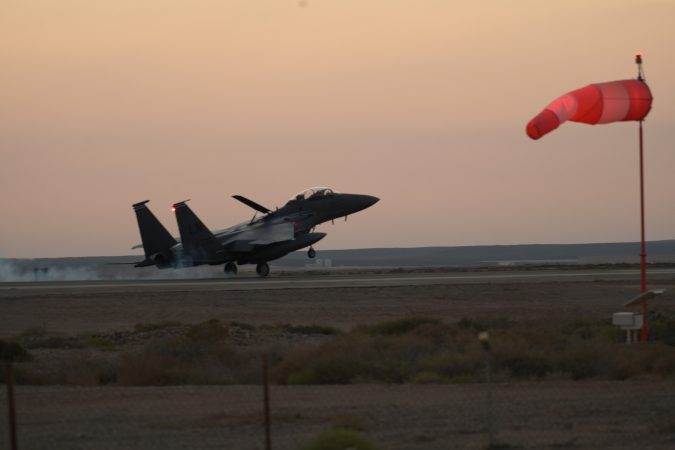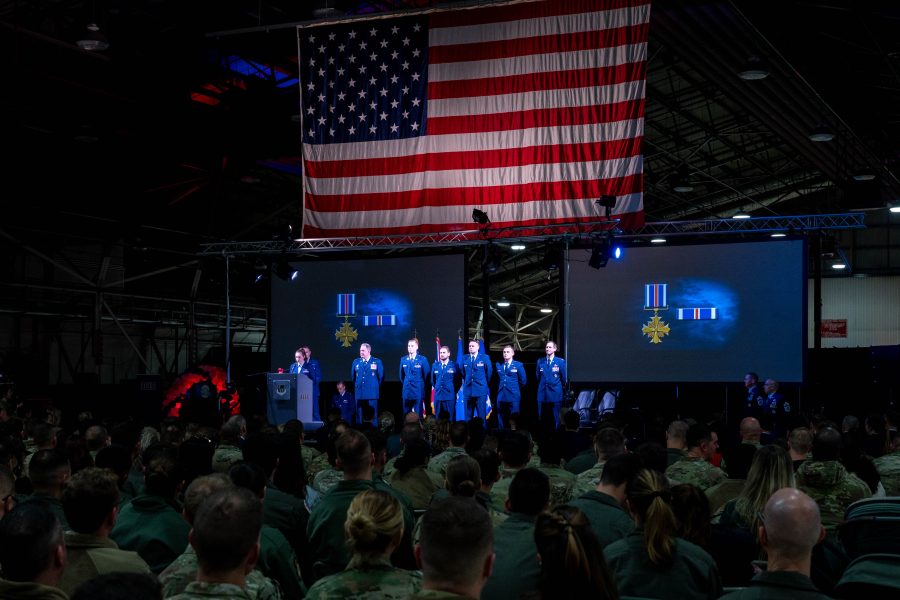This is the third and final installment in a multipart series based on exclusive interviews with nine Airmen who helped respond to Iran’s April 13 attack on Israel. Part 1 and Part 2 are available here.
RAF LAKENHEATH, U.K.—Below the F-15E Strike Eagles, the swirl of missiles, interceptors, and debris flying through the night lit up the night sky like the Northern Lights, one Airman recalled.
Iran had launched more than 300 one-way attack drones, ballistic missiles, and cruise missiles at Israel and the attack was now at it its crescendo. After following orders to “launch to survive,” fighters from the 494th Fighter Squadron were airborne and confronting their mission.
“‘All right, take five seconds to breathe, get our wingmen up with us, because they finally were able to take off,’” Capt. Logan Cowan, an F-15E pilot, recalled thinking. “And then it’s like an ‘everything happening everywhere, all at once’ scenario.”
In addition to F-15E and F-16 fighters, USAF tankers and command-and-control aircraft were in the air, as were aircraft from coalition partners and Israeli interceptors.
“The totality of the situation was, ‘Oh sh–,’” Cowan mouthed.
Ahead of Cowan’s formation, Maj. Benjamin Coffey and Capt. Lacie “Sonic” Hester were back in the thick of things, airborne for the second time that night, having left their bunker at the base in the midst of an Alert as other personnel took shelter from the attack. They launched in a new jet after returning to base with a missile that failed to fire.
Like their first sortie, Coffey and Hester quickly expended all their missiles; again, one failed to fire. As a last resort, they fired their F-15E’s 20mm gun, but with limited effect.
As airborne mission commanders, however, they still had work to do.
“We need to coordinate the other fighters. We need to coordinate for our partners, so that they know where the threat is,” Coffey said. “And at that point, instead of trying to do subsequent gun attempts, we bring fighters back … we reset where the fight is going on, and we start handing off threats.”
Three other fighters from the squadron remained in the air, including a two-ship flown by Capts. Cowan, Gabriel Diamond, Trace Sheerin, and Brian Tesch that was entering the fight for the first time.
“We’re just all over the place, hunting down the tracks that other jets picked up and where they saw the drones and cruise missiles,” Tesch said.
The attack seemed to have petered out. But then the crews got word from Coffey and Hester that a few “straggler” drones were 300 or so miles away. Snapping in that direction, the F-15Es raced to intercept them as they approached a city.
“Obviously that makes the hairs on the back your neck stand up,” said Sheerin. “If you’re out in the middle of the desert, that’s fine. If something misses, something goes wrong, the worst that happens is … a random crater that could have been from an asteroid pops up somewhere in the desert.
“But as soon as you start throwing in completely innocent people who have nothing to do with this conflict, and now you have explosives flying over them, and heavily laden supersonic fighter jets flying very low altitude over them, that complicates the equation quite a bit.”
Cowan and Diamond were the flight leads, but Sheerin and Tesch were in a better position to take the first shot.
“We’ve set up the intercept, and I’m waiting for him to shoot,” said Cowan. “I query him once, I query him twice, and then all of a sudden, I look up and this missile just flies off his jet and explodes in the center of my field of view.”
Despite their exhilaration, however, they decided against trying for a second intercept—the risk too great given the chance of civilian harm. Instead, they passed custody of the target off to coalition fighters further back.
Gen. James B. Hecker, head of U.S. Air Forces in Europe, praised that decision during a Nov. 12 ceremony decorating members of the 494th. Amid the excitement and adrenaline of aerial combat, the restraint the crews showed stood out in its own way.
After that, most U.S. fighters returned to base, while Cowan, Diamond, Sheerin, and Tesch still had to fly for several hours more. In the wake of adrenaline-infused takeoffs and dramatic shootdowns, quiet now descended as the sun rose in the east.
Looking out, the Airmen saw dozens, if not hundreds, of trails of smoke from missiles and interceptors winding through the sky.
“Like a ball of yarn,” Sheerin said.
“Like a bird’s nest,” Tesch said.
“It was one of the most incredible things I’ve ever seen,” Cowan said. “Because the sun is shining through all these missile smoke trails, it looks like a bowl of spaghetti in the sky.”
For the next several hours, the last two F-15Es patrolled the airspace as the impact of what had just happened sank in.
Coffey and Hester, returning to base, also took stock.
“We can see the Iron Dome [Israeli air defense system] going off in the distance. We can see base defense fires from all the bases around us going off. And there is a long period of about 20 minutes where we just talked about, ‘Did we do enough?’” Coffey said.

Aviators and maintainers turned on the news and got their answer: 99 percent of all drones and missiles had been intercepted, and the few that got through caused minimal damage and no fatalities. What some have called the biggest drone attack in history had been thoroughly thwarted.
“After everything was down, and all the hung missiles were put up, and we had already re-armed and got ready to go for a second round, then we had time to breathe and start processing what actually happened,” said Staff Sgt. Ethan Tarver.
The entire squadron, Coffey said, breathed a collective sigh of relief. And in the days and weeks to follow, they were able to appreciate just how much they had done, said Staff Sgt. Kendra Wertsbaugh.
“What we did was very important, saved many lives, and also showed that times are changing, and with unmanned aerial devices [threatening allies], we are prepared to just defend against anything,” Wertsbaugh said.
On Nov. 12, leaders, dignitaries, and scores of fellow Airmen gathered in a hangar at Lakenheath to recognize those accomplishments. On a stage set up beside an F-15E, Hecker handed out awards ranging from the Air & Space Achievement Medal to the Distinguished Flying Cross and Bronze Star. Hester became the first woman in the Air Force to receive the Silver Star.
And if, as Hecker said during the ceremony and Air Force leaders have often repeated as of late, the nature of warfare is changing, then members of the 494th can look back on that night in the Middle East as a key moment.
“I’m too young, too inexperienced even now to be able to tell you where warfare will go in the future. That’s not my purview,” said Sheerin. “But with how things continue to change, I know from the lessons learned in this as a squadron … as a fighter community specifically, I think we’re moving in a good direction, and I think we will be able to continue to assess and improve specifically with the lessons learned from the 13th of April.”
Part 1 and Part 2 are available here.
494th Fighter Squadron Decorations
Silver Star Medal
- Maj. Benjamin Coffey
- Capt. Lacie Hester
Bronze Star Medal
- Maj. Clayton Wicks
- Master Sgt. Timothy Adams
Distinguished Flying Cross
- Lt. Col. Curtis Culver (V)
- Lt. Col. Timothy Causey (V)
- Capt. Logan Cowan (V)
- Capt. Gabriel Diamond (V)
- Capt. Trace Sheerin (V)
- Capt. Brian Tesch (V)
- Capt. Matthew Eddins (C)
- Capt. Garrett Benner (C)
- Capt. Austin Leake (C)
- Capt. Stepan Volnychev (C)
- Capt. Claire Eddins
- Capt. Carla Nava
- Capt. Kyle Abraham
- Capt. Eric Edelman
(V) indicates a Valor device, (C) indicates a combat device
Air and Space Commendation Medal
- Capt. Alexander Thennes
- Master Sgt. Michael Bialaski
- Tech. Sgt. Brandon Brown
- Staff Sgt. Sarah Moir
- Staff Sgt. Kendra Wertsbaugh
- Staff Sgt. Daniel White
Air and Space Achievement Medal
- Staff Sgt. Michael Wright
- Staff Sgt. Ethan Tarver
- Senior Airman Ardo Dia
- Senior Airman Sanders Joseph
- Senior Airman Rico Sanchez
- Airman First Class Treyvon Walker


